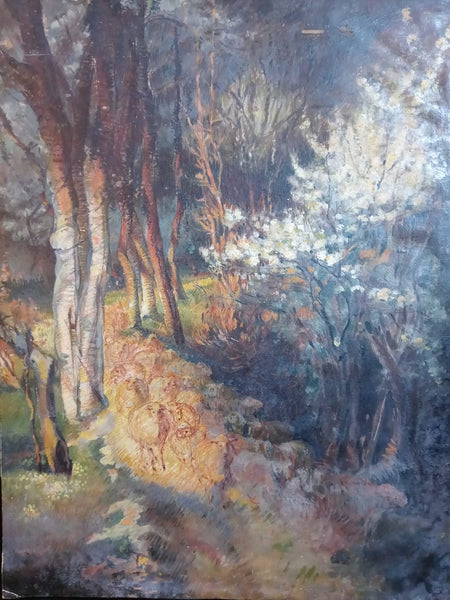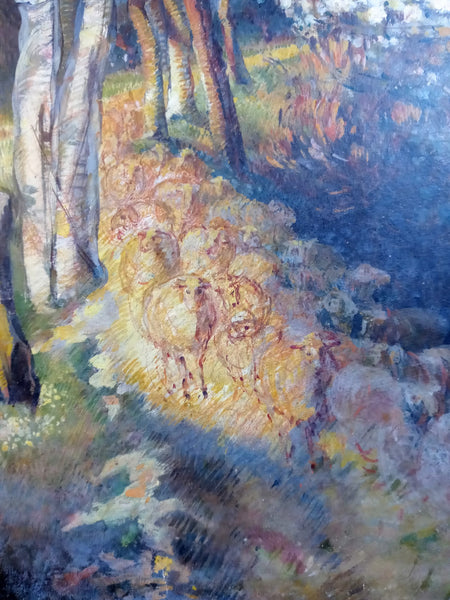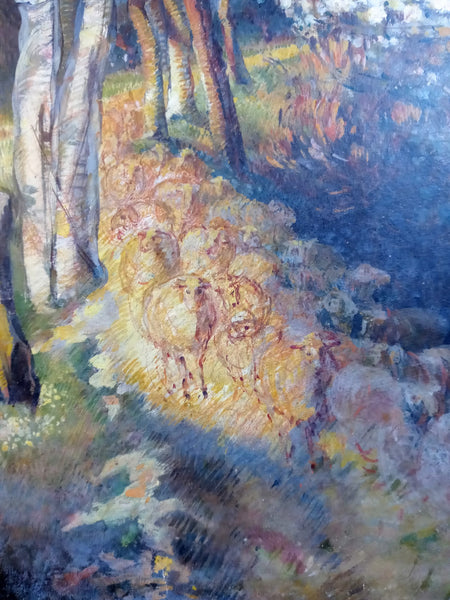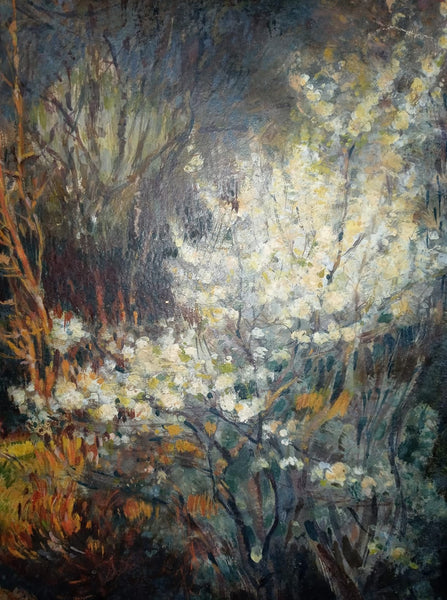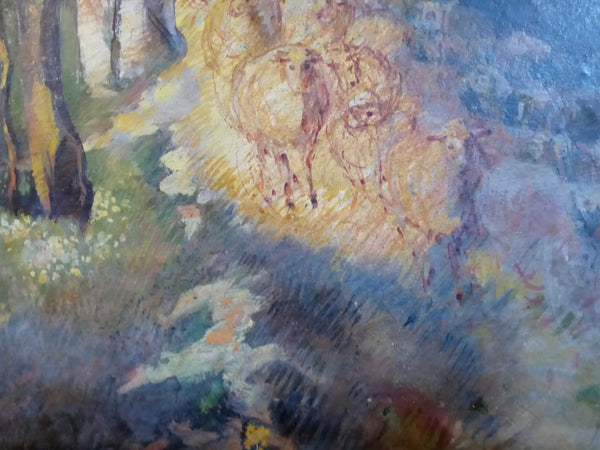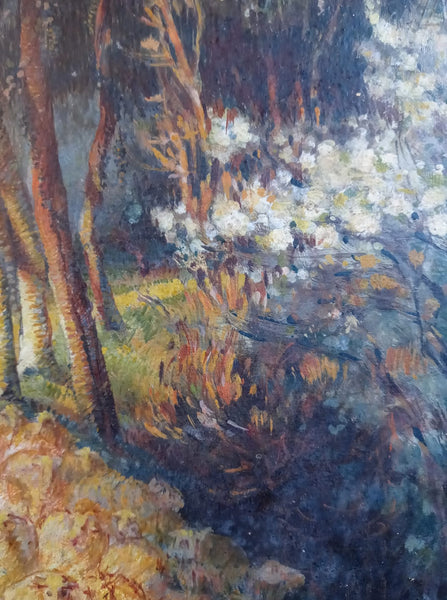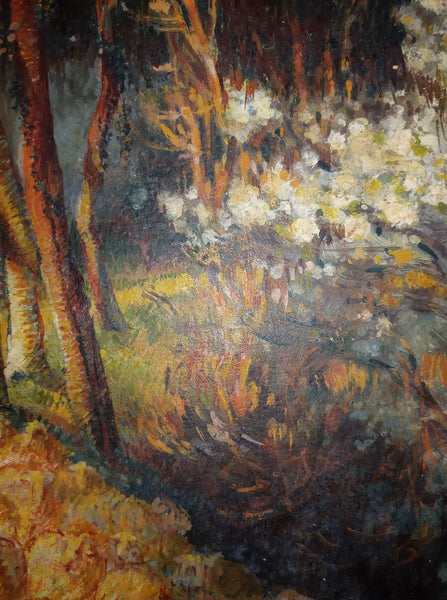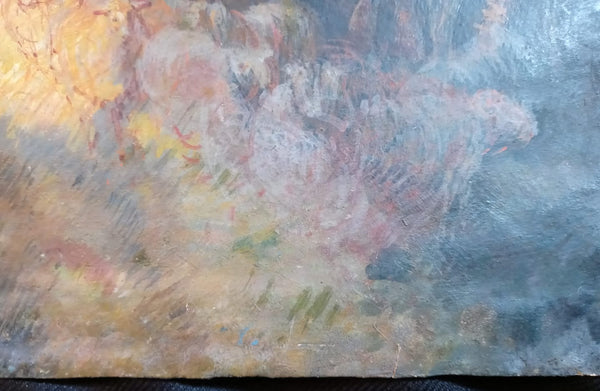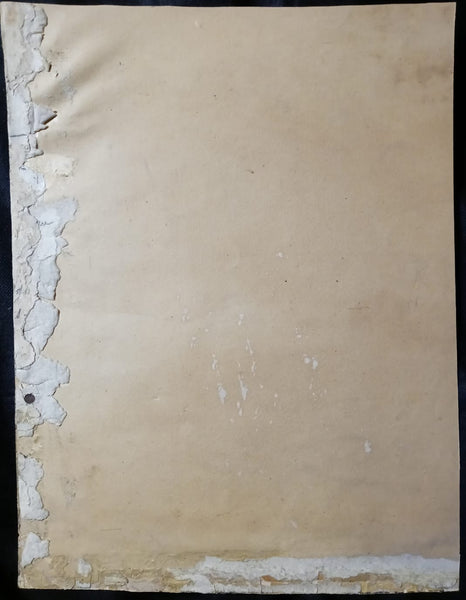Berthe Morisot Original Antique 19th Century French Impressionist Sanguine Mixed Media Oil Painting Forest Landscape Sheep
Berthe Morisot Original Antique 19th Century French Avant-Garde Impressionism Sanguine Oil Mixed Media Painting Wooded Forest Landscape with Sheep
Original 19th Century French Berthe Marie Pauline Morisont antique sanguine and oil on heavy woven paper, impressionist oil painting of sheep in a wooded forest landscape. The painting is in overall good condition, and the paint is very stable, however, some is waving in the upper right corner, as shown. It appears this painting was preserved onto a thick paper backing, and there may be another layer. The painting measures approximately 11.4" X 14.8", and is unframed. It is estimated to have been created in approximately the 1890s.
Berthe Marie Pauline Morisot was a French painter and a member of the circle of painters in Paris who became known as the Impressionists. She was born on January 14, 1841, in Bourges, France, into an affluent bourgeois family. Her father, Edmé Tiburce Morisot, was the prefect (senior administrator) of the department of Cher, and her mother, Marie-Joséphine-Cornélie Thomas, was the great-niece of Jean-Honoré Fragonard, a prolific Rococo painter. Morisot had two older sisters, Yves and Edma, and a younger brother, Tiburce. The family moved to Paris in 1852 when Morisot was a child.
Morisot received private art education along with her sisters and was taught by Geoffroy-Alphonse Chocarne and Joseph Guichard. In 1857, they were introduced to the Louvre gallery, where they learned by copying paintings. Despite the limitations imposed on women at the time, Morisot pursued her passion for art and befriended other artists, including Édouard Manet and Claude Monet.
In 1864, Morisot exhibited for the first time in the esteemed Salon de Paris, the official annual exhibition of the Académie des beaux-arts. Her work was selected for exhibition in six subsequent Salons until 1874 when she joined the "rejected" Impressionists in their first independent exhibition, held at the studio of the photographer Nadar. Morisot continued to participate in all but one of the following eight Impressionist exhibitions, held between 1874 and 1886.
Morisot's marriage to Eugène Manet, the brother of her friend and colleague Édouard Manet, further strengthened her connection to the art world. She had a close relationship with Édouard Manet, who painted several portraits of her. Morisot and Eugène had a daughter named Julie, who frequently posed as a model for her mother and other Impressionist artists.
As an artist, Morisot went through different periods in her work. She initially worked in watercolor and pastel, later transitioning to oil painting. Her style evolved from capturing domestic scenes and landscapes to exploring more ambitious themes, such as nudes. Morisot's works were characterized by light brushstrokes, a delicate color palette, and a sense of intimacy. She was praised for her virtuosity as a colorist and her ability to create a translucent atmosphere in her paintings.
Morisot's paintings were exhibited in various prestigious galleries and museums. She participated in Impressionist exhibitions and displayed her works alongside renowned artists such as Monet, Manet, Degas, Renoir, and Pissarro. Her paintings were well-received, and critics recognized her as one of the leading Impressionists. In 1877, a critic for Le Temps described her as the "one real Impressionist in this group."
Today, Morisot's artworks can be found in major museums worldwide. Some notable institutions that house her paintings include the Musée d'Orsay in Paris, the Metropolitan Museum of Art in New York City, the National Gallery in London, and the Hermitage Museum in Saint Petersburg. Her works continue to be celebrated for their elegance, lightness, and their depiction of everyday life, particularly the lives of women in the late nineteenth century.
Berthe Morisot passed away on March 2, 1895, in Paris, due to pneumonia, which she contracted while attending to her
ailing daughter Julie, who had contracted the illness. Morisot's untimely death at the age of 54 was a great loss to the art world, as she had contributed significantly to the Impressionist movement and left behind a remarkable body of work.
Even though Morisot faced challenges and societal restrictions as a female artist during her time, she managed to break barriers and establish herself as a respected painter. Her unique perspective, mastery of color, and innovative approach to capturing light and atmosphere continue to inspire and influence artists to this day.
Contact Us:
pacificfineart@gmail.com
424-259-3290









